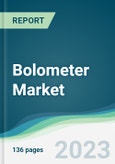The bolometer market was valued at US$731.228 million in 2021 and is expected to grow at a CAGR of 16.07% during the forecast period.
A bolometer is a type of sensor used to measure electromagnetic radiation's power in the infrared, microwave, and radio frequency range. Bolometer works by measuring the temperature rise caused by radiation absorption in a detector material, typically a thin film of metal or semiconductor. Bolometers are used in applications like thermal cameras, particle detectors, and fingerprint scanners because of their high sensitivity to temperature changes. The increasing demand for high-precision images, high-sensitivity & high-resolution detectors for particles, and biometric authentication in various industries are driving the demand for bolometers, thereby positively impacting their market growth.The increasing adoption of thermal cameras is boosting the growth of the bolometer market.
Thermal cameras detect the radiation emitted by objects and convert it into a visual image, allowing users to see the temperature variations across a scene. The usage of such cameras is increasing rapidly in various industries such as security and surveillance, automotive, and healthcare. Bolometers are used in thermal cameras to detect and measure the temperature of objects and environments, which is essential for detecting anomalies, monitoring equipment, and identifying energy losses. The growing demand for thermal cameras in various industries and applications is expected to boost the demand for bolometers. The International Air Transport Association (IATA) reported that the use of thermal cameras increased by 600% in 2020 as airports and airlines implemented measures to screen passengers for signs of fever. In 2020, the WHO reported that thermal imaging was used extensively in hospitals, clinics, and other healthcare facilities worldwide. This demonstrates that bolometers hold a great demand in the future.The growing use of fingerprint scanners is augmenting the demand for bolometers.
Fingerprint scanners have become increasingly popular for biometric identification in recent years. The bolometer is used to detect the heat emitted by the ridges and valleys on the surface of a fingerprint as it is pressed against a sensor, and these heat patterns are unique to each individual. They can be used to identify a person with high accuracy. Using a bolometer in fingerprint scanners is advantageous because it allows sensitive temperature measurements. The increasing usage of fingerprint scanners is driving the demand for bolometers. The International Biometrics + Identity Association (IBIA) reported in 2021 that biometric technologies such as fingerprint scanners have become more prevalent and widely accepted for use in various applications, including mobile devices, financial services, and travel and border security. The US Department of Homeland Security (DHS) reported in 2020 that it has continued to use fingerprint scanners for border security.The North American region is expected to hold a significant market share throughout the projected period.
North America holds a significant market share due to many key players operating in the bolometer market, the growing awareness about the benefits of bolometers in various research applications, and the favorable government initiatives and funding in the region. In 2020, the US Department of Homeland Security (DHS) Science and Technology Directorate announced a new program called the Low-Cost Thermal Camera Development Program, which aimed to develop low-cost thermal imaging technology that could be used for various applications, such as border security, search and rescue operations, and firefighting. The program funded several companies and organizations to develop new thermal camera technologies. In 2019, the Canadian government invested $59 million in biometric technology to improve border security and reduce wait times for travelers entering the country, including the deployment of new fingerprint scanners and facial recognition technology at various border crossings and airports across the country. The growing usage of thermal cameras and fingerprint scanners will boost the demand for bolometers.Market Developments:
- January 2022: National Library of Medicines (NLM) introduced micromechanical bolometers for subterahertz detection that could unleash the full potential of numerous applications in security, healthcare, and industrial production.
- September 2020: A team of researchers at Aalto University and VTT Technical Research Center jointly developed a bolometer to improve energy quanta measurement during quantum computing.
Market Segmentation:
By Type
- Microbolometer
- Hot-Electron Bolometer
By Application
- Thermal Cameras
- Particle Detectors
- Fingerprint Scanners
- Others
By Geography
- North America
- USA
- Canada
- Mexico
- South America
- Brazil
- Argentina
- Others
- Europe
- UK
- Germany
- France
- Spain
- Others
- Middle East and Africa
- Saudi Arabia
- UAE
- Israel
- Others
- Asia Pacific
- China
- Japan
- India
- South Korea
- Others
Table of Contents
1. INTRODUCTION
2. RESEARCH METHODOLOGY
3. EXECUTIVE SUMMARY
4. MARKET DYNAMICS
5. BOLOMETER MARKET BY TYPE
6. BOLOMETER MARKET BY APPLICATION
7. BOLOMETER MARKET BY GEOGRAPHY
8. COMPETITIVE ENVIRONMENT AND ANALYSIS
9. COMPANY PROFILES
Companies Mentioned
- Honeywell International Inc.
- Infinite Electro-Optics (Ascendent Technology Group)
- Infrared Laboratories
- QMC Instruments Ltd
- Teledyne DALSA (Teledyne Technologies)
Methodology

LOADING...








